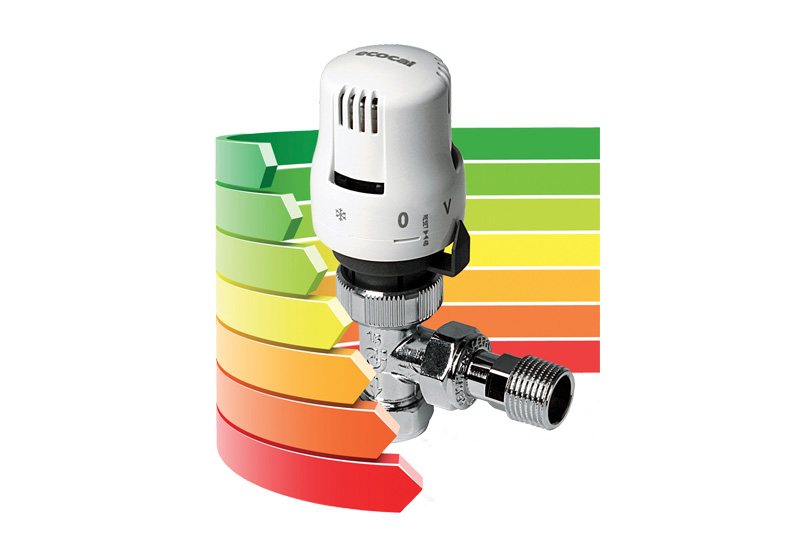
Not all TRVs are the same and as we constantly strive to improve energy efficiency in the face of increasing bills and legislation, A-rated TRVs represent a relatively untapped sales opportunity for merchants. So says Steve Boyd, Head of Trade Sales at Altecnic.
Most homeowners and all of your installer customers will be aware of thermostatic radiator valves and how they can be used to reduce heating bills. However, they may not be aware of the scale of energy savings that are possible when selecting A-rated TRVs.
An Ecofys-Institute study found that efficiency improvements as high as 19% of the heating energy of a radiator can be achieved when replacing a manual radiator valve with an A-rated TRV. Based on the average cost of an A-rated TRV, it would take less than two years for homeowners to reap the rewards of their investment.
Furthermore, when compared to other common heating energy saving options, such as hydraulic balancing or installing a new system, thermostatic TRVs have the shortest payback period.
Of course, not all TRVs are the same which is why in Europe the TELL classification scheme provides clear guidance to consumers via the thermostatic efficiency label. The right to use ‘A-rated’ energy efficiency labelling can only be granted to products that fulfil the minimum requirements in line with EN 215 with adherence to influence of water temperature, hysteresis, response time and influence of differential pressure.
The first most obvious opportunity for your customer is to replace manual radiator valves with A-rated TRVs.
And while there appear to be no figures for the number of such valves in the UK, a recent report from the European Building Automation Controls Association estimates that about 500 million uncontrolled valves are still mounted on radiators across the EU. If all of these were upgraded with TRVs, then EU citizens, including those in the UK, would save a staggering 12 billion euros per year and reduce CO2 emissions by about 24 million tonnes.
Liquid wins
Some TRVs are better than others, which is why the TELL rating system is so important. TRVs work by sensing the air temperature around them and regulating the flow of water through the radiator to which they are fitted. It does this by using a sensor in the TRV head which is filled with a material that expands as the room temperature rises and contracts when it drops.
The weight and density of the material used to fill this sensor affects the time it takes for the TRV to respond to a temperature change in a room. A liquid filling will expand and contract more quickly than a heavier material like wax, which is still used in some products. For the end customer, this means that a liquid filled TRV offers a faster response time for better comfort and improved energy savings.
A liquid filled TRV is also less likely to deteriorate. The crystalline composition of wax means that it tends to get harder and heavier over time with constant expansion and contraction. This affects its ongoing accuracy, so after a couple of years consumers may find that they have to increase their temperature settings to achieve the same level of comfort, thus negating any energy savings.
Further sales
This means that there is a strong case for replacing inferior manual radiator valves with better, A-rated thermostatic versions. There is however even more reason to install new, efficient TRVs that may currently be being overlooked — particularly by homeowners.
For example, anytime that a new boiler is fitted the heating system should be upgraded accordingly if it is to achieve its full potential. Indeed, the government-produced “Domestic Building Services Compliance Guide” suggests that “it is convenient and timely to fit thermostatic radiator valves when replacing a boiler.”
So why not ask your trade counter customer next time they buy a boiler if they also need A-rated TRVs?
There is also the potential for additional sales that comes with the large TRV replacement market in the UK, because this technology has been around for at least a couple of decades.
Modern A-rated TRVs are more efficient than older versions, but there is also a chance that if an existing system is older than 15 years then the TRV may have stopped working. Some homeowners may make the mistake of turning off the TRV for prolonged periods in the summer, during which time it could calcify or collect debris. This could cause the internal pin to cease and possibly the seal on the pin to break.
To conclude, not all TRVs are the same and older ones could be inefficient or have even stopped working and need replacing. By asking your trade customers if they need “A” rated TRVs you will be saving the end customer energy and money by selling a better product, your installer will win extra higher value business and ultimately, so will you.









